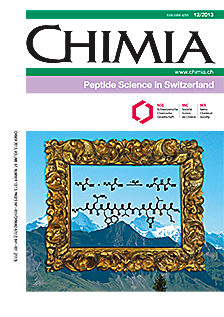Design and Applications of Protein Epitope Mimetics
DOI:
https://doi.org/10.2533/chimia.2013.885Keywords:
Antibiotic, Peptide, Peptidomimetic, Protein epitope mimetics, VaccineAbstract
Macromolecular structures represent an interesting starting point for the design and synthesis of small-molecule mimetics of surface epitopes that mediate protein–protein and protein–nucleic acid interactions. The resulting protein epitope mimetics (PEMs) provide a source of new biologically active molecules that are useful as biomolecular probes in chemical biology, as well as novel drug or vaccine candidates. This is illustrated here through studies on PEMs as synthetic vaccine candidates targeting the malaria parasite and the human immunodeficiency virus type-1 (HIV-1). In addition, various folded PEMs with ?-hairpin structures have been designed that target protein–protein and protein–nucleic acid interactions, as well as others that interact with cellular receptors such as CXCR4 and the bacterial outer membrane protein LptD. In this last example, the PEMs possess a novel antibiotic activity that has so far not been observed with traditional small synthetic molecules or natural products.Downloads
Published
2013-12-18
Issue
Section
Scientific Articles
License
Copyright (c) 2013 Swiss Chemical Society

This work is licensed under a Creative Commons Attribution-NonCommercial 4.0 International License.
How to Cite
[1]
J. A. Robinson, Chimia 2013, 67, 885, DOI: 10.2533/chimia.2013.885.







